MY TWO “GREAT 8’s”
Throughout the history of firearms, many different cartridges have been developed for specific purposes. Most have their day in the sun then fade away; others have a long life span, usually in other roles than the one their original designers had in mind. While it’s not always the case, many were meant to meet the demands of the military authorities: put bluntly, they were intended to kill people efficiently and reliably. A lot of the commercial calibers we think of as “sporting” rounds were originally intended for use by soldiers. It’s no accident that they successfully made the transition from military to sporting use: anything that’s an efficient killer of humans is likely to be equally good at killing man-sized game animals. Furthermore, a caliber adopted for military use becomes familiar to those who serve in the nation’s armies: when those men are demobilized and want to go hunting they gravitate towards the cartridge on which they were trained and which they know best.
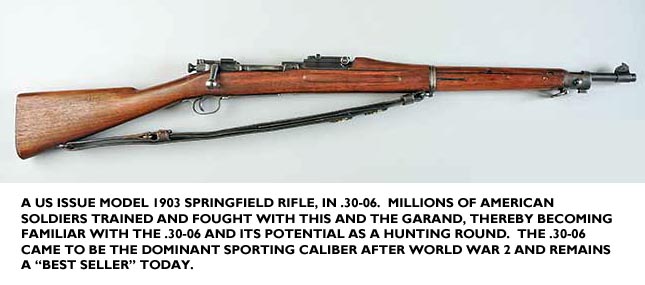 Probably the best known example of this transition is the .30-06, with which two generations of American soldiers became familiar using it in the Model 1903 Springfield and Garand rifles. The .30-06 has sterling qualities that have rightly made it the “yardstick” by which all other sporting calibers are measured. The .308 Winchester, introduced in the 1950’s, had a relatively short “military career,” but since it’s well suited to medium game it too quickly made the grade for sporting use. Ditto the .223, adopted 55 years ago and now one of the hottest sellers in the sporting ammunition market. Even the venerable .45-70 (first introduced in 1873 as the US Army’s official rifle caliber) carries on as an excellent hunting round for any North American game.
Probably the best known example of this transition is the .30-06, with which two generations of American soldiers became familiar using it in the Model 1903 Springfield and Garand rifles. The .30-06 has sterling qualities that have rightly made it the “yardstick” by which all other sporting calibers are measured. The .308 Winchester, introduced in the 1950’s, had a relatively short “military career,” but since it’s well suited to medium game it too quickly made the grade for sporting use. Ditto the .223, adopted 55 years ago and now one of the hottest sellers in the sporting ammunition market. Even the venerable .45-70 (first introduced in 1873 as the US Army’s official rifle caliber) carries on as an excellent hunting round for any North American game.
The .30-40 Krag is a bit of an exception to this statement. It was official issue only briefly (1892-1903) at a time when the US Army was a very small force. There’s certainly nothing wrong with the Krag round as a hunting caliber, but thanks to limited use it never really caught on as a big seller. The introduction of the purely sporting .30-30 in 1895 didn’t help the .30-40’s prospects, either. The two are reasonably close ballistically, but the Winchester Model 1894 is a light, flat, sleek rifle compared to the porky and cumbersome Krag-Jorgensen. In some ways it’s surprising that the .30-40 is still loaded by ammunition companies, because few sporters ever chambered it, and the supply of shootable surplus rifles has long since dried up.
 The phenomenon isn’t restricted to American ammunition. Both the .303 British and the 8x57 Mauser rounds date to the mid 1880’s but thanks to use in two world wars and innumerable smaller ones over more than eight decades, tens of millions of men who trained and fought using them came to understand and respect their virtues. They have seen wide use in the hunting field. The .303 is still popular in Canada, and it was brought to the Indian subcontinent and much of Africa thanks to the far-flung British Imperial presence.
The phenomenon isn’t restricted to American ammunition. Both the .303 British and the 8x57 Mauser rounds date to the mid 1880’s but thanks to use in two world wars and innumerable smaller ones over more than eight decades, tens of millions of men who trained and fought using them came to understand and respect their virtues. They have seen wide use in the hunting field. The .303 is still popular in Canada, and it was brought to the Indian subcontinent and much of Africa thanks to the far-flung British Imperial presence.
 The political unification of Germany took a long time, which put the Germans behind in establishing colonies, but by the 1880’s the Kaiser’s Schutztruppe brought the 8x57 to newly-acquired colonies in Southwest Africa and German East Africa (now Burundi, Rwanda, and the mainland part of Tanzania). Many nations of Eastern Europe and the Middle East adopted the 8x57 as well, thanks to aggressive marketing by the Mauser firm and to the German foreign policy of providing arms and ammunition as a way to counter the influence of France and Britain, especially in the Middle East.
The political unification of Germany took a long time, which put the Germans behind in establishing colonies, but by the 1880’s the Kaiser’s Schutztruppe brought the 8x57 to newly-acquired colonies in Southwest Africa and German East Africa (now Burundi, Rwanda, and the mainland part of Tanzania). Many nations of Eastern Europe and the Middle East adopted the 8x57 as well, thanks to aggressive marketing by the Mauser firm and to the German foreign policy of providing arms and ammunition as a way to counter the influence of France and Britain, especially in the Middle East.
The 8x57 had its origins in a late 19th Century arms race. In 1886 France adopted the 8mm Lebel round, the first high-velocity, small bore military rifle cartridge using smokeless powder. It made all other nations’ infantry arms obsolete more or less overnight. I find it interesting that the 8mm Lebel round seems to have had comparatively limited use as a hunting caliber because it's about like a .308 in power. I’m speculating here, but I think this may have been due to hunting conditions in France and/or French colonial policies designed to deprive native tribes of modern arms. Furthermore, the ungainly Model 1886 Lebel rifle wasn’t really suited as the base for a sporting rifle, and its fat, rimmed, heavily tapered cartridge is poorly adapted to magazine feeding.
The Germans were at the time using the Mauser Model 1871/84 that used a black powder round typical of the pre-Lebel era: the 11x60mm Mauser fired a fat lead bullet at very modest velocity and with an arched trajectory. The 8mm Lebel by comparison had a lighter bullet moving at a speed fast enough to give it a flatter trajectory and much greater range than the lumbering bullet of the 11mm Mauser round.
Germany understood that its hereditary enemy had suddenly outstripped it in the development of small arms and—quite rightly—assumed that sooner or later the French would seek revenge for their humiliating defeat in the Franco-Prussian War of 1870. Something had to be done. So (in keeping with a practice that dates at least as far back as the Peloponnesian War) the German government convened…a committee. The “Reichsgewehr Kommission” was charged with finding a replacement for the obsolete Mauser and its plodding caliber; and wonder of wonder, they came up with a solution that actually worked.
The rifle they designed had some of the characteristics of a Mannlicher and a few Mauser-like features but it was neither. The “Gewehr 1888” (“Rifle, Model 1888”) was a clip fed repeater. Most importantly it was chambered for an entirely new cartridge specifically designed to match the performance of the original Lebel round. This new cartridge was the rimless “7.92x57mm,” in its original form loaded with a jacketed round nosed bullet weighing 215 grains and having a diameter of 0.318”. It far outclassed the 11x60mm Mauser: the Gew 88 was immediately adopted by the German forces, the Kaiser heaved a sigh of relief, and the balance of power between Germany and France (temporarily) was re-established.
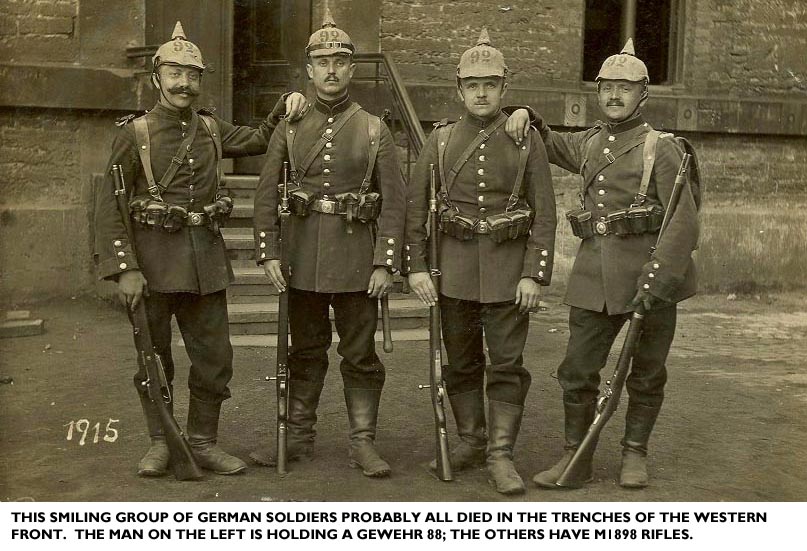
In subsequent years some changes were made to the Gew 88; but in truth it was never much more than a “stopgap” rifle to begin with. Of course Herr Mauser hadn’t been idle: in the years after 1888 he produced a series of bolt action repeaters that sold well to other countries, and eventually designed what must be regarded as his masterpiece, the Gewehr 1898. This very strong action was greatly superior to the Gew 88 and the German government adopted it as a new standard issue, relegating older rifles to use by the Landwehr (reserve forces) and some colonial troops.
The 7.92x57 had been battle tested in Africa by German forces consolidating their hold on German East and West Africa, and it was used by German forces in the Boxer Rebellion. As always happens with new weapons, a few post-adoption design changes were put into effect. The most important of these was intended to increase its effective range. In 1905 the bullet it fired was changed to a diameter of 0.323” and altered to a “spitzer” (pointed) shape. This new bullet was lighter, more aerodynamic, and had a better trajectory than the older one. This change led to a confusing terminology. The older caliber using the 0.318” bullet is today referred to as the “8x57 J,” for “Infantry.” The “J” and “I” are interchangeable in the German alphabet. The larger-diameter 0.323” bullet is the “8x57S” or “8x57JS,” to designate the “spitzgeschoss,” or pointed spitzer bullet. It’s important not to get the two diameters confused. The post-1905 cartridge is what today we know as the “8mm Mauser.” Not surprisingly it’s traditionally associated with the various Model 1898 battle rifles used in both World Wars.

Many millions of military Model 1898’s in 8x57 were made and issued: no one really knows how many. A pretty sizable proportion of them eventually ended up in the USA after WW Two, sold off for desperately needed hard currency by a recovering Germany. During the halcyon period of unrestricted importation and mail order sales they were bought by two generations of World War veterans at prices that make one weep today. Model 1898 Mausers in 8x57 were so cheap in the 1950’s and 60’s that many of them were “sporterized” by bargain-minded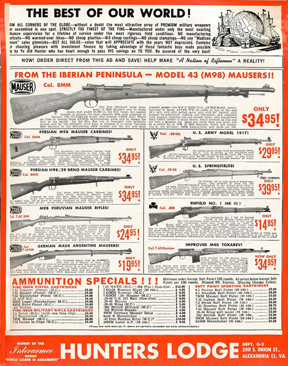 Bubbas to use as hunting guns. There was quite a fad for this in the late 50’s to mid 60’s, because in a day when a Winchester Model 70 cost $75 or so, a $35 Mauser and a hacksaw produced a “sporter” of vile appearance but effective enough performance.
Bubbas to use as hunting guns. There was quite a fad for this in the late 50’s to mid 60’s, because in a day when a Winchester Model 70 cost $75 or so, a $35 Mauser and a hacksaw produced a “sporter” of vile appearance but effective enough performance.
The huge influx of surplus rifles gave the 8x57 a foothold in the US: ammunition makers responded to the demand for hunting ammunition and the caliber became established here, though it wasn’t chambered in many (if any) US made rifles. The ammunition companies recognized that in addition to the M1898's, many thousands of older Gew 88 rifles, whose actions are much weaker than the M1898's (and some of them still having the older 0.318” barrels) were still in existence. They were very cautious in their approach to the market for 8x57 sporting ammunition, loading it only to a very modest level of performance that would be safe in both actions. This essentially reduced it to the level of the venerable .30-40 Krag, but since that’s adequately powerful for almost all North American game, especially white-tailed deer, nobody minded.

But in Europe where the 8x57 was still widely used things were done differently. The 8x57 had established itself as a hunting caliber in the same way the .30-06 did here, but curiously enough, the “J” bore of 0.318” was almost always retained for sporting rifles, for decades after 1905. This was probably due to the nature of Germany’s market for sporting guns. Unlike the US, hunting was (and is) the preserve of an elite population; rifles were made on more or less a custom basis for individual buyers, not mass produced in huge numbers. Gunsmiths tend to be an independent group of craftsmen, and I suppose many of them felt (correctly) that the 0.318” bore was perfectly adequate, so why change? Customers bought their ammunition from the man who supplied the rifle, anyway, so there wasn’t much chance they’d get the wrong stuff.

The Gew 88 action itself was slim and trim, so a great many elegant lightweight sporters were built on surplus Gew 88 actions. Virtually all of these have a 0.318” barrel. In my experience the bore/groove diameter of any German or Austrian-made sporting rifle of the period 1890-1950 should be checked before use to determine the proper bullet size. And while sporters built on Model 1898 actions usually use 0.323” bullets, this isn’t always true: again, a custom-made rifle of German or Austrian origin—especially one made in the 1920’s or early 1930’s—might well have been ordered with the smaller bore.
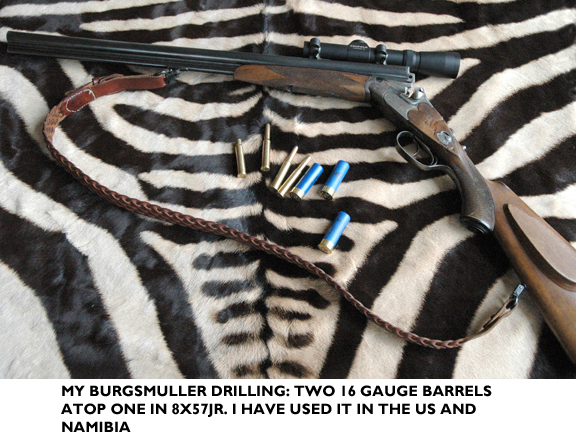
In eastern Europe, especially in Germany and Austria, combination guns were also very popular sporting weapons. Most of these are three-barrel “drillings” (from drei, German for “three”) with two shotgun barrels and a rifle barrel on one frame. A very popular caliber for these was the rimmed  version of the 8x57, a kissing cousin of the rimless military round. The designation used for this variant is “8x57R,” and again, the “J” or “S” suffix is needed to indicate what the proper bullet size to use is. Thus a drilling (if marked for caliber at all) might bear the stamp “8x57JR,” to indicate the smaller bullet must be used. Most drillings in the USA came here as war souvenirs in 1945 and shortly thereafter, and they will almost always be in the “J” size. Drillings are still made, though new production guns are “8x57JRS,” to indicate a barrel bored for the 0.323” bullet. Anyone fortunate enough to own a drilling must be absolutely certain what size bullet it uses because the thin-walled rifle barrels may well burst if a too-large bullet is fired through them. With the passing of the years the “J” bore is fading out of use slowly, but one European ammunition company (Sellier & Bellot) still loads the 8x57JR.
version of the 8x57, a kissing cousin of the rimless military round. The designation used for this variant is “8x57R,” and again, the “J” or “S” suffix is needed to indicate what the proper bullet size to use is. Thus a drilling (if marked for caliber at all) might bear the stamp “8x57JR,” to indicate the smaller bullet must be used. Most drillings in the USA came here as war souvenirs in 1945 and shortly thereafter, and they will almost always be in the “J” size. Drillings are still made, though new production guns are “8x57JRS,” to indicate a barrel bored for the 0.323” bullet. Anyone fortunate enough to own a drilling must be absolutely certain what size bullet it uses because the thin-walled rifle barrels may well burst if a too-large bullet is fired through them. With the passing of the years the “J” bore is fading out of use slowly, but one European ammunition company (Sellier & Bellot) still loads the 8x57JR.
The overwhelming dominance of American ammunition companies, gun makers, and American sport hunters in the hunting market in the aftermath of World War Two led to increasing popularity of American rifles and calibers in Europe. Over several decades American soldiers and diplomats stationed in Europe (especially in Germany) took advantage of the great hunting to be found there, but they tended to do it with rifles they’d brought from home, and these were for the greatest part chambered for the .30-06. Similarly, in the “Golden Age” of African hunting in the 1950’s and 60’s American calibers were preferred. In response to the demands of visiting Americans European ammunition companies produced their own lines of ammunition in American calibers. While they never stopped producing the 8x57, the predominance of the American rounds, especially the .30-06, led to it being used less and less even in Europe and by African professional hunters and guides. A PH in Namibia—where at one time the 8x57 was widely used thanks to the country’s origin as a German colony—would almost never expect to see a client show up using a rifle in 8x57. I know this to be the case: I was one who did, and my PH was astounded at my choice of caliber: no one he’d guided had ever done that. That said, he acknowledged it to be a fine choice for bushveld hunting of plains game. And so it proved to be.
As mentioned above, the 8x57 gets short shrift from American companies. Fearful of lawsuits, they fail to take advantage of its full potential. Furthermore, most American 8x57 is loaded with light bullets to boost velocity: 99.9% of American hunters believe that “Faster is better and don’t you ever forget it.” Muzzle velocity is the average hunter’s criterion for judging the power and performance of a cartridge, to the exclusion of all other factors. Nor do the American companies offer much variety in their 8x57 lines; one (at most two) bullet weights and styles.
Two examples will suffice to make my point here. Remington loads the 8x57 with only one weight of their excellent Core-Lokt bullet, 170 grains. This bullet is pushed to a nominal velocity of 2360 FPS. That is only 200 FPS faster than Remington’s .30-30 with the same weight bullet! Remington’s .30-40 Krag fires a 180-grain bullet at 2430 FPS. Thus, Remington’s sole offering in 8x57 is less effective (on paper, of course) than the Krag round and is not much more than a somewhat enhanced .30-30.
Winchester also loads the 8x57. Again, only a single choice exists in their line: the 170-grain Power Point. It moves at 2360 FPS, identical to Remington’s version. Winchester’s .30-40 Krag and .30-30 are also identical to Remington’s offerings.
But anyone who served in the Second World War and was subjected to German riflery with their military 8x57 knows that the caliber is capable of vastly better performance. 8x57 produced by European makers (such as Norma and S&B among others) has ballistics comparable to those of the .30-06 and .308 Winchester. As loaded in Europe the 8x57 is an entirely different round.
Norma produces the 8x57 with four different bullet styles: one FMJ, two soft-points (the Oryx and Alaska) and a hollow point, the Vulkan. Their FMJ is the lightest, at 123 grains, moving at 2822 FPS. The Oryx—as the name implies this is designed for African game—has a 196 grain bullet at 2526 FPS; the Alaska and Vulkan bullets are also 196 grains at 2526 FPS. For purposes of comparison, Norma’s .308 Winchester uses the same style bullets, but maxes out at 180 grains, at 2610 FPS. Thus Norma’s 8x57 is directly comparable to their .308 and far outclasses what Remington and Winchester produce. S&B offers two styles of bullet (FMJ and a soft point) in the 196 grain weight, and at the same velocity as Norma’s ammunition.
S&B is the only company still loading the 8x57JR, the rimmed round for use in drillings and combination guns. They offer only a soft point in this caliber. Traditionally, since a drilling’s break action is regarded as weaker than a bolt action, the 8x57JR is somewhat less powerful than the rimless version. Nevertheless, S&B’s 8x57JR has a 196-grain bullet at 2329 FPS. That’s insignificantly slower than the Remington/Winchester 8x57, with a bullet 26 grains heavier!
I have some extensive personal experience with both the 8x57 and the 8x57JR; but I’m the only person I know of who hunts with these two calibers. How I came to be a user of the 8x57’s is a story in itself. My father was a physician. One of his patients was the only woman I knew in my early teen years who hunted. She and I would have discussions about hunting while she was waiting to see him: she used an old military Mauser when she hunted in Pennsylvania and strongly recommended the 8x57 to me for deer. When I began hunting deer in New York, I could only use a shotgun, but after moving to Virginia I purchased a .30-06 and had great success with it here and on my first African hunt. A few years later I was planning a second safari, to Namibia.
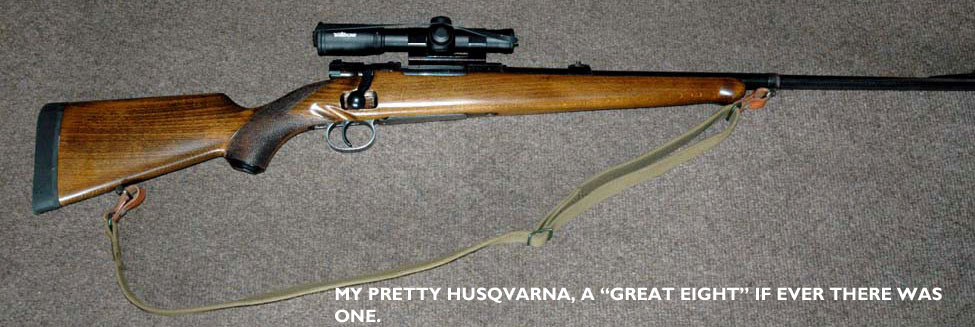
Knowing that Namibia was a former German colony I thought that perhaps it would be fitting to use the classic 8x57 as my rifle for plains game. I’d found a very pretty Husqvarna on an auction site, and purchased it for a very reasonable price.
Before I took it to Namibia I hunted with it here in the USA: it took a very big whitetail buck in Giles County, and a nice fat free-roaming hog in Tennessee. Both these were killed with Remington ammunition. But for Namibia I wanted more power, so I purchased Norma’s “Oryx” and “Alaska” varieties. That safari proved that my Husky—purchased on a whim and for possibly a trivial reason—was a wise choice, and that it was one of those “lucky” guns. I used it to kill an impala, a springbok, a Hartmann’s Mountain zebra, a warthog, and an enormous Livingstone eland, all of them one-shot kills using Norma ammunition. Along the way it accounted for a baboon or two and one or two black-backed jackals (both of these species are considered vermin to be shot on sight).
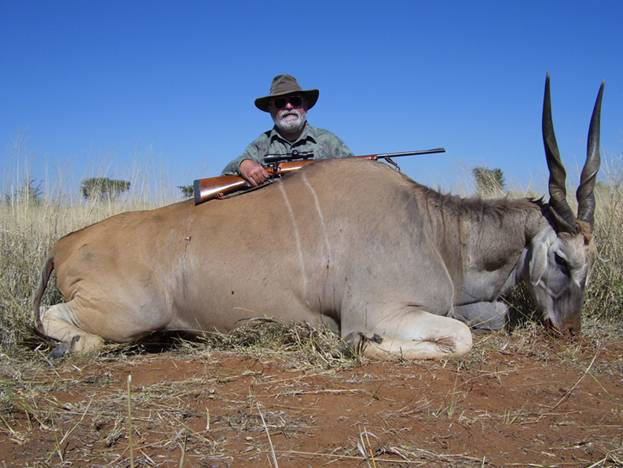


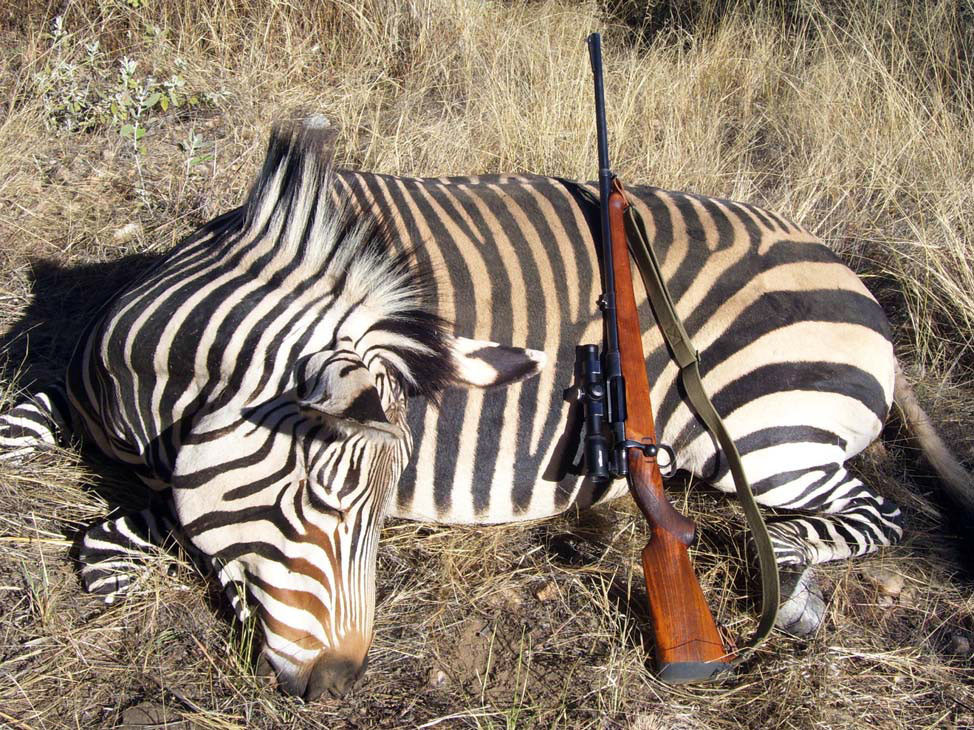
Eventually, back here in Virginia it became my “culling” rifle for deer on a kill permit. I’ve been culling for a friend, again with Remington’s ammunition. The Husky has never failed me: everything I’ve shot with it has died, right then and there, and I attribute its terrific performance on African plains game to the excellent Norma product that allows the 8x57 to be used at its full potential. I could never have made those clean kills on big African species using the American-made product, I’m certain.
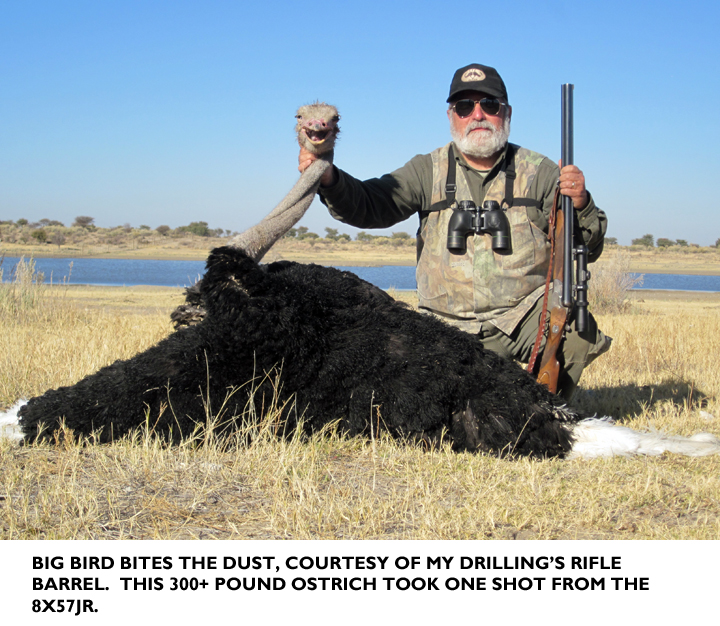
As for the 8x57JR, the rimmed round, that too has been a great choice. I have a beautiful German-made drilling that I’ve used here and in Africa. I killed a massive whitetail buck here, and an enormous feral hog in Tennessee, then took it to Africa on my second Namibian trip because it could double as a shotgun. It did that, but it also accounted for 5 more jackals and an big bull ostrich, again all one-shot kills, using S&B’s product.
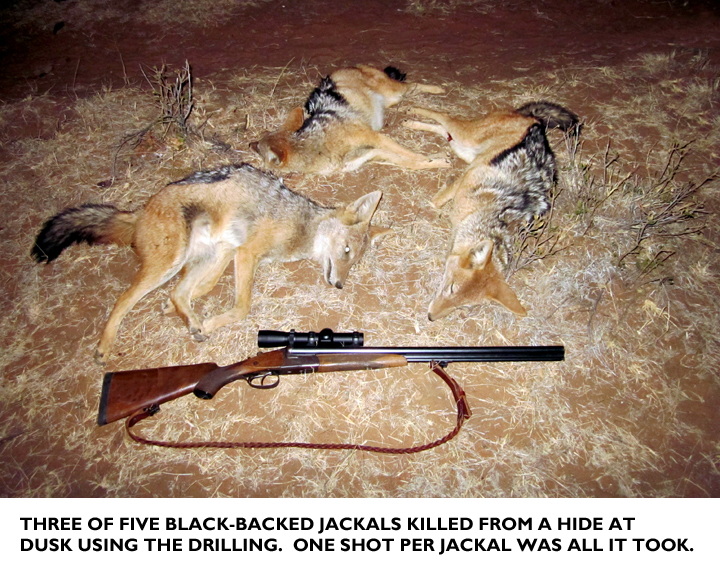
So long as Norma and S&B make these two calibers I doubt I’ll have to handload for either, but I have done so, using Norma components. Alas, Norma dropped the 8x57JR as a factory offering, but I was able to score a couple of boxes of their Oryx bullets sold as reloading components. Boxer primed brass and 0.318” bullets are available through at least two suppliers, but unfortunately the selection of 8mm bullets for reloading is limited. It’s nowhere near so wide as those for the .30-caliber rounds nor even the 7mm’s.
Given that Norma no longer makes the 8x57JR I do have some concern that S&B may drop production too, since it’s a very old round whose adherents are moving to more “modern” calibers; I fear its days are numbered. But I can load for that, too and have done so. The only real dimensional difference is the presence of the rim, so standard 8x57 dies can be used, with the addition of one that sizes the neck to the proper tension for the slightly smaller 0.318” bullet. For the foreseeable future of my hunting life I’ll be able to feed both guns and I’m sure they’ll continue to serve me well.
I do have other rifles, but the little Husqvarna and my drilling—my two “Great Eights”—occupy special places in my gun cabinet and in my hunting memories.
| HUNTING | GUNS | DOGS |
| FISHING & BOATING | TRIP REPORTS | MISCELLANEOUS ESSAYS |
| CONTRIBUTIONS FROM OTHER WRITERS|
| RECIPES |POLITICS |
 Probably the best known example of this transition is the .30-06, with which two generations of American soldiers became familiar using it in the Model 1903 Springfield and Garand rifles. The .30-06 has sterling qualities that have rightly made it the “yardstick” by which all other sporting calibers are measured. The .308 Winchester, introduced in the 1950’s, had a relatively short “military career,” but since it’s well suited to medium game it too quickly made the grade for sporting use. Ditto the .223, adopted 55 years ago and now one of the hottest sellers in the sporting ammunition market. Even the venerable .45-70 (first introduced in 1873 as the US Army’s official rifle caliber) carries on as an excellent hunting round for any North American game.
Probably the best known example of this transition is the .30-06, with which two generations of American soldiers became familiar using it in the Model 1903 Springfield and Garand rifles. The .30-06 has sterling qualities that have rightly made it the “yardstick” by which all other sporting calibers are measured. The .308 Winchester, introduced in the 1950’s, had a relatively short “military career,” but since it’s well suited to medium game it too quickly made the grade for sporting use. Ditto the .223, adopted 55 years ago and now one of the hottest sellers in the sporting ammunition market. Even the venerable .45-70 (first introduced in 1873 as the US Army’s official rifle caliber) carries on as an excellent hunting round for any North American game. The phenomenon isn’t restricted to American ammunition. Both the .303 British and the 8x57 Mauser rounds date to the mid 1880’s but thanks to use in two world wars and innumerable smaller ones over more than eight decades, tens of millions of men who trained and fought using them came to understand and respect their virtues. They have seen wide use in the hunting field. The .303 is still popular in Canada, and it was brought to the Indian subcontinent and much of Africa thanks to the far-flung British Imperial presence.
The phenomenon isn’t restricted to American ammunition. Both the .303 British and the 8x57 Mauser rounds date to the mid 1880’s but thanks to use in two world wars and innumerable smaller ones over more than eight decades, tens of millions of men who trained and fought using them came to understand and respect their virtues. They have seen wide use in the hunting field. The .303 is still popular in Canada, and it was brought to the Indian subcontinent and much of Africa thanks to the far-flung British Imperial presence.  The political unification of Germany took a long time, which put the Germans behind in establishing colonies, but by the 1880’s the Kaiser’s Schutztruppe brought the 8x57 to newly-acquired colonies in Southwest Africa and German East Africa (now Burundi, Rwanda, and the mainland part of Tanzania). Many nations of Eastern Europe and the Middle East adopted the 8x57 as well, thanks to aggressive marketing by the Mauser firm and to the German foreign policy of providing arms and ammunition as a way to counter the influence of France and Britain, especially in the Middle East.
The political unification of Germany took a long time, which put the Germans behind in establishing colonies, but by the 1880’s the Kaiser’s Schutztruppe brought the 8x57 to newly-acquired colonies in Southwest Africa and German East Africa (now Burundi, Rwanda, and the mainland part of Tanzania). Many nations of Eastern Europe and the Middle East adopted the 8x57 as well, thanks to aggressive marketing by the Mauser firm and to the German foreign policy of providing arms and ammunition as a way to counter the influence of France and Britain, especially in the Middle East.

 Bubbas to use as hunting guns. There was quite a fad for this in the late 50’s to mid 60’s, because in a day when a Winchester Model 70 cost $75 or so, a $35 Mauser and a hacksaw produced a “sporter” of vile appearance but effective enough performance.
Bubbas to use as hunting guns. There was quite a fad for this in the late 50’s to mid 60’s, because in a day when a Winchester Model 70 cost $75 or so, a $35 Mauser and a hacksaw produced a “sporter” of vile appearance but effective enough performance.

 version of the 8x57, a kissing cousin of the rimless military round. The designation used for this variant is “8x57R,” and again, the “J” or “S” suffix is needed to indicate what the proper bullet size to use is. Thus a drilling (if marked for caliber at all) might bear the stamp “8x57JR,” to indicate the smaller bullet must be used. Most drillings in the USA came here as war souvenirs in 1945 and shortly thereafter, and they will almost always be in the “J” size. Drillings are still made, though new production guns are “8x57JRS,” to indicate a barrel bored for the 0.323” bullet. Anyone fortunate enough to own a drilling must be absolutely certain what size bullet it uses because the thin-walled rifle barrels may well burst if a too-large bullet is fired through them. With the passing of the years the “J” bore is fading out of use slowly, but one European ammunition company (Sellier & Bellot) still loads the 8x57JR.
version of the 8x57, a kissing cousin of the rimless military round. The designation used for this variant is “8x57R,” and again, the “J” or “S” suffix is needed to indicate what the proper bullet size to use is. Thus a drilling (if marked for caliber at all) might bear the stamp “8x57JR,” to indicate the smaller bullet must be used. Most drillings in the USA came here as war souvenirs in 1945 and shortly thereafter, and they will almost always be in the “J” size. Drillings are still made, though new production guns are “8x57JRS,” to indicate a barrel bored for the 0.323” bullet. Anyone fortunate enough to own a drilling must be absolutely certain what size bullet it uses because the thin-walled rifle barrels may well burst if a too-large bullet is fired through them. With the passing of the years the “J” bore is fading out of use slowly, but one European ammunition company (Sellier & Bellot) still loads the 8x57JR.





